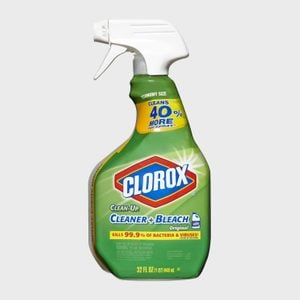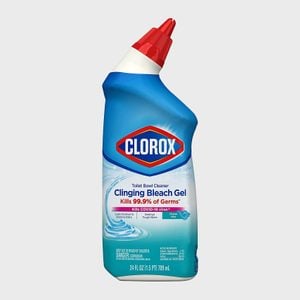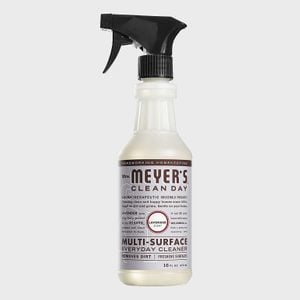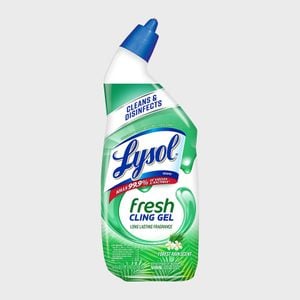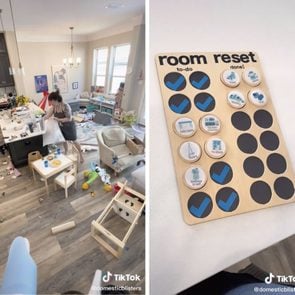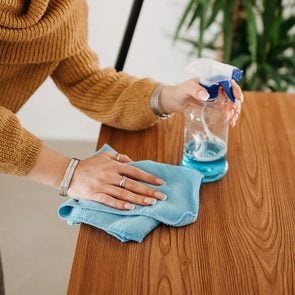How to Clean a Toilet the Right Way
Updated: May 16, 2024
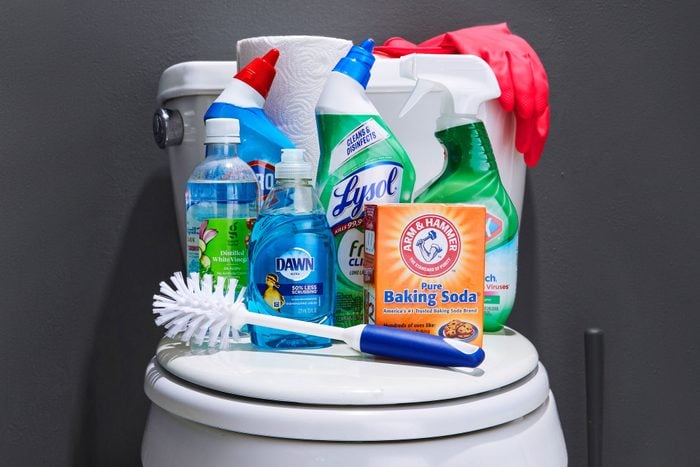
Using the best disinfecting techniques, experts reveal exactly how to clean your toilet to keep bacteria buildup at bay
If you hate cleaning and sanitizing bathrooms, you aren’t alone. It’s the most hated household chore in America, according to a recent survey by Lombardo Homes. And we get it. Who wants to scrub away soap scum or stick their hand in a dirty toilet? While it might not sound fun, learning how to clean a toilet the right way (just like learning how to clean a shower, how to clean a tub, how to clean a faucet head and how to clean glass shower doors) is absolutely essential to your health—and your bathroom’s.
“Toilet cleaning duty isn’t the most glamorous chore, but given the potential bacteria and odors that can be harbored in your bathroom, it’s one of the most important areas in your home to clean correctly,” says Vanesa Amaro, a cleaning influencer on TikTok.
The bad news? There tends to be more involved in cleaning a toilet than just squirting a solution inside the basin. The good news? There are only a few more necessary steps to clean your toilet the right way. Whether you’re cleaning your bathroom top to bottom or just tackling a weekly refresh, here are expert-approved tips on how to clean your toilet—from the bowl and tank to the exterior and basin.
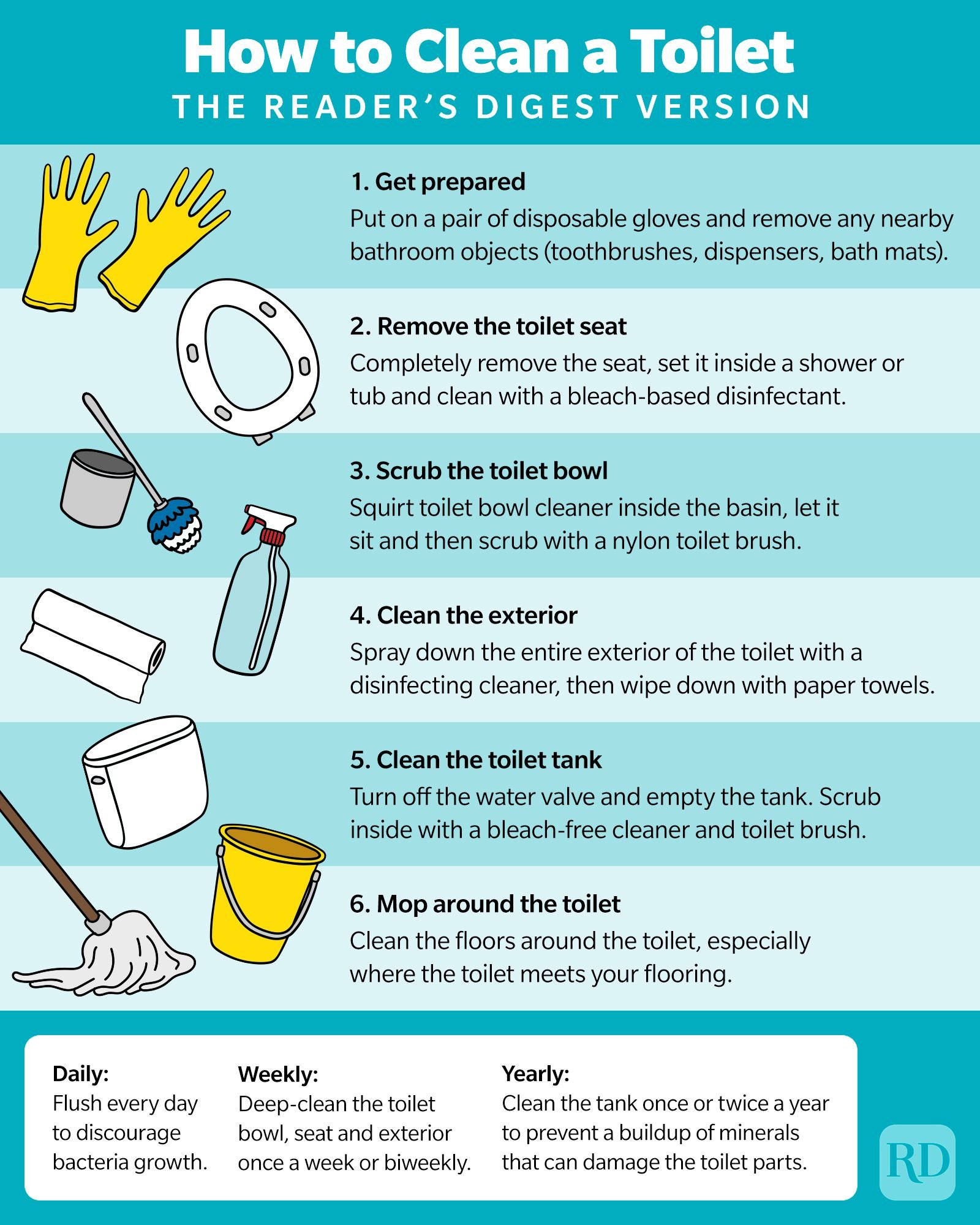
On This Page
How often should you clean your toilet?
“The toilet is one of the germiest surfaces in your home,” says Amaro. Without regular deep-cleanings, you could face harmful bacteria, pink slime, buildup, rust, stubborn stains and even mold growth inside your toilet bowl. According to Amaro, a good rule of thumb for a high-traffic area like your bathroom (toilet included) is to clean it weekly. “That said, your cleaning schedule is going to vary based on your household. How many people live in your home? How many people are regularly using this bathroom in particular?”
- Daily: Flush your toilet every day (even if it’s not in use) to discourage the growth of bacteria.
- Weekly: Deep-clean your toilet once a week or biweekly—this includes the toilet bowl, exterior and toilet seat.
- Yearly: Clean your toilet tank twice a year. “Do this to avoid mildew, rust and grime and to prevent a buildup of minerals that can damage the parts,” says Alicia Sokolowski, a cleaning expert and co-CEO of AspenClean.
How to clean a toilet
Cleaning a toilet might be a particularly crappy chore, but it’s one with major health consequences, should it not be done properly. “A toilet flush can send E. coli bacteria into the air in your bathroom for up to six hours,” says Sokolowski. Cleaning it (in the proper order) is also important for rust, stain and mold removal. The minerals in the toilet water can stain your toilet bowl, and these stains can pick up and trap dirt particles and bacteria. “In some cases, if the bacteria spread, they can make people sick if they use the toilet and don’t wash their hands after,” Sokolowski adds. Here’s how to clean your toilet—properly and effectively.
Supplies:
- Gloves
- Toilet bowl cleaner
- Bleach-based disinfecting cleaner
- Paper towels
- Toilet brush or brush set
- Dish soap
- White vinegar
- Baking soda
Directions:
1. Prepare the area
Before you start, put on a pair of disposable gloves and prep the area by removing any bathroom objects on nearby counters, such as hairbrushes, makeup brushes and toothbrushes. Be sure to remove and wash your bath towels and bath mats as well.
2. Remove the toilet seat
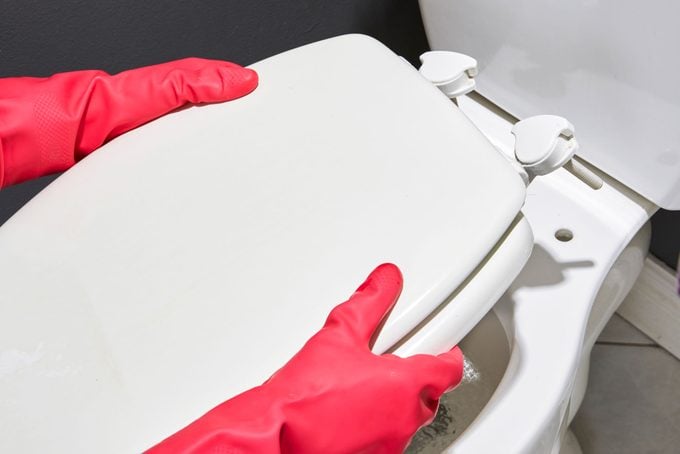
Completely remove the toilet seat and set it inside your bathtub or shower. “Spray it down with a disinfecting bleach cleaner and allow the product to sit according to the label instructions,” Amaro says. “When tackling the bathroom, I always clean the toilet first, followed by the shower or tub. That way, I’m not setting the dirty seat inside my recently cleaned tub.”
3. Add toilet bowl cleaner
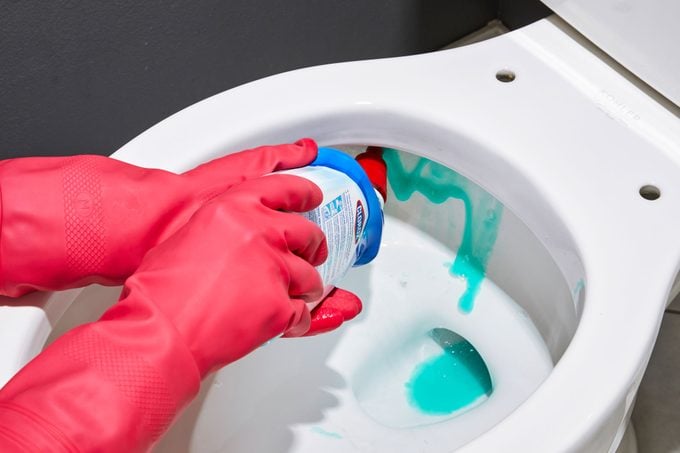
Squirt the toilet bowl cleaner inside the bowl and let it sit for the recommended time. If you’d like to make a homemade solution, Sokolowski says to pour 2 cups of vinegar into the toilet bowl and 1 cup of baking soda. When the solution stops fizzing, spread it over the bowl with the toilet brush. Leave it for 10 to 15 minutes.
4. Clean the rim
While the toilet bowl cleaner is working, spray the toilet bowl rim with a disinfecting bleach cleaner and wipe it down with paper towels. “I love using reusable microfiber cloths when it comes to most areas of my home, but when cleaning the toilet, I stick to paper towels that I can throw away when I’m done,” Amaro says.
5. Scrub down the toilet bowl
After wiping the seat area and letting the bowl cleaner work its magic, take a toilet brush and scrub down the bowl. Flush when you’re done.
6. Clean the exterior of the toilet
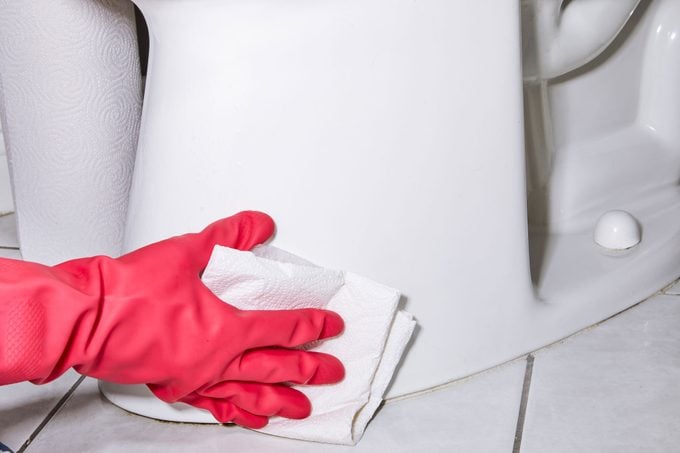
Spray down the entire exterior of the toilet, including the base and exterior of the tank, with a disinfecting cleaner. Wipe down with paper towels. “Make sure you’re cleaning all the way down to where your toilet meets the floor,” Amaro says. “You never know what’s lingering down there, and paper towels and a disinfecting cleaner is the best way to tackle this hard-to-reach area.”
7. Mop the surrounding area
Amaro recommends mopping your bathroom floor to make sure you’re picking up any remaining mess, especially in the area around the base of your toilet. Whether you’re cleaning tile floors, cleaning laminate floors or cleaning marble floors in your bathroom, you’ll want to follow these floor-cleaning tips.
8. Disinfect your cleaning tools
Your cleaning tools also need a quick clean to avoid potentially spreading germs, Amaro notes. Putting your toilet brush away while it’s wet and dirty is one cleaning mistake that’ll make your home dirtier. Soak your toilet brush with a disinfecting cleaner. Then, after clipping your toilet seat back in place, set it between the seat and the rim so the brush can drip into the toilet. Allow the brush to dry fully.
How to clean a toilet tank
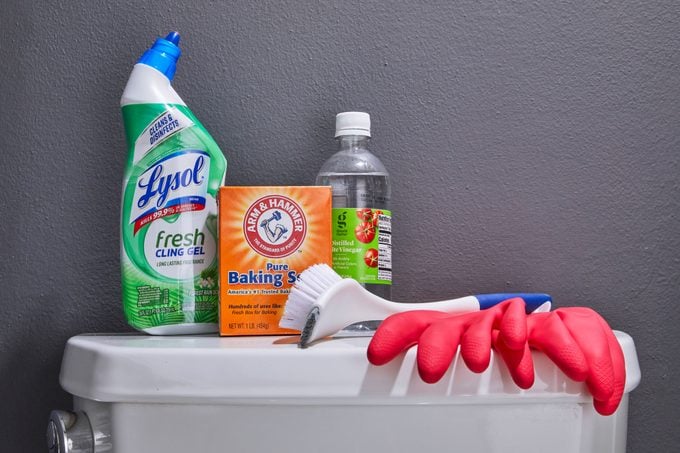
Supplies:
Directions:
1. Pre-soak the tank with vinegar
If the tank has a lot of mineral buildup, you can add 4 cups of vinegar and allow it to soak for about an hour.
2. Empty the tank
Turn off the water valve and flush a few times until the tank drains completely, instructs Amaro.
3. Spray the tank down
Spray the inside of the tank with a bleach-free, disinfecting cleaner. “Don’t use bleach when cleaning your toilet tank,” says Amaro. “It can corrode the metal parts inside and lead to bigger issues for your toilet.”
4. Scrub the interior of the tank
After spraying the tank down, the real work starts. “Using a long-handled scrub brush, scrub along the walls, corners and bottom of the tank,” says Amaro. Wipe down the interior parts of the tank, like the ball float, flapper and handlebar, with a bit of bleach-free cleaner as well.
5. Refill the toilet
After completing the cleaning process, turn the water valve back on and allow the tank to refill.
Alternate method
Sokolowski offers another cleaning method for the tank. Without draining out the water, pour white vinegar into the tank, stopping at least an inch below the top rim, she says. Let that water-vinegar solution sit for 12 hours to dissolve mineral deposits, rust and mildew. Then, flush the toilet a couple of times to remove the vinegar from the tank.
How to clean a bidet
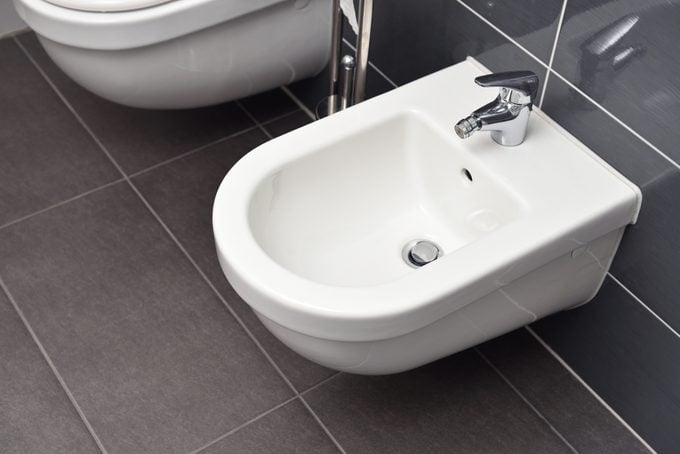
Bidets use a stream of water to clean you off after you use the bathroom. Bidets usually come in two forms: a basin that attaches to your toilet, or a separate fixture that sits next to your toilet. “No matter what type you have, it’s important to always use mild cleaning products, like dish soap,” Amaro says. “The standalone bidet’s ceramic surface can easily be damaged, and an add-on bidet includes electric elements.”
Supplies:
- Gloves
- Dish soap
- Old toothbrush or deep-clean brush set
Directions:
Clean a separate bidet
To clean a separate bidet, first use a damp paper towel to wipe away dust and dirt on the seat and in the bowl. “For more substantial dirt, wipe down using a damp paper towel soaked in a mild dish soap.” Once everything dries, you can clean the nozzle using a damp soft bristle toothbrush.
Clean a bidet attachment
When cleaning a bidet attachment, make sure to never fully submerge it in water, notes Amaro. “Most bidets have a self-cleaning feature that extends the nozzle out.” For a particularly messy occurrence, give the nozzle an additional gentle wipe-down using a damp paper towel or toothbrush with mild dish soap. You can then clean your toilet as you normally would.
The best toilet cleaners
How to clean toilet stains
Generally, most stains are removable. But some stains from hard water, rust, mold and mildew growth can be particularly stubborn. Here’s how to clean toilet stains: For hard-water stains, Amaro suggests adding 3 to 4 cups of vinegar and a cup of baking soda to the bowl, allowing the mixture to fizz and then sit for about 10 minutes. Then, scrub down your bowl with a toilet brush. Allow the solution to sit for another 30 minutes, then flush. “A pumice stone toilet brush is also a great option to scrub away mineral buildup, like calcium and iron,” she adds. It’s important not to overuse this method though, reserving it only for occasional deep-cleaning.
Pro toilet cleaning tips to keep in mind
- Don’t mix cleaning products. There are some cleaning products you should never mix. “Mixing products can be very dangerous, especially in areas without proper ventilation,” Amaro says.
- Be careful with bleach. When cleaning with bleach-based products, never make these bleach mistakes, such as mixing it with ammonia or any other cleaner. “Make sure to follow the instructions on product labels and properly dilute bleach,” Amaro says.
- Ventilation is important. Make sure to always work in a well-ventilated area, whether opening a nearby window or turning on the exhaust fan.
- Consider the material and shape of your toilet. Most toilets are made of porcelain, which is a nonporous material safe to be cleaned with disinfectant cleaners. But the shape of your toilet may impact how you approach cleaning the base. “I recently moved, and we chose to upgrade the toilets to those with an elongated base without any nooks where pee, hair and grime can collect,” Amaro says. “Depending on your toilet, you might need to be more mindful of deep-cleaning the base and any hard-to-reach corners.”
Sources:
- Vanesa Amaro, cleaning influencer on TikTok and spokesperson for Clorox
- Alicia Sokolowski, president and co-CEO of AspenClean
- Lombardo Homes: “Chores Americans Hate the Most”



















